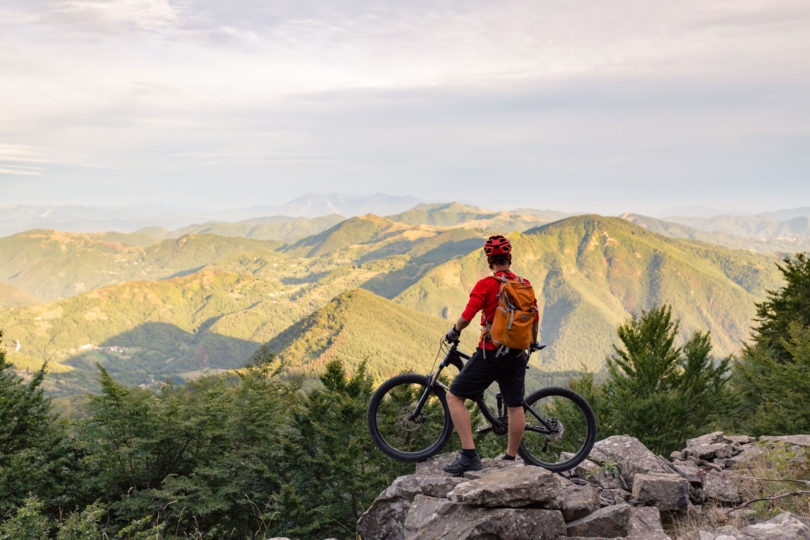An Internet search for “What is bikepacking?” shows it is, among other things, one of the fastest growing aspects of cycling, with dozens of explanations, tips and even videos. As for what it actually entails, that varies.
Bikepacking, in its basic form, is a self-supported style of mountain biking. Riders load their camping gear on their bicycles and take off for the woods for a few hours, a few days or even a few weeks or more. It started gaining in popularity in the early 2000s and really has taken off in the past decade.
“It doesn’t have to be this crazy ultra-experience,” says Robert Maye, who owns Red Barn Bicycles in Barhamsville, Va. “It can be something you can do with the family. There are a lot of options you have with bikepacking.”
Behind the Bikepacking Trend
Sasha Digges, a 50-year-old bikepacking enthusiast from Williamsburg, Va., says safety is one reason that the sport has grown in popularity among cyclists. The roads can be dangerous for cyclists. In 2018, within weeks of each other, a 50-year-old cyclist from York County and a 46-year-old Chesapeake cyclist were struck and killed by cars. The Chesapeake man was believed to have been walking his bike at the time.
“People are starting to get scared of being on the road,” Maye says.
Statistics back up those sentiments. In 2018, 13 cyclists lost their lives on the roads of Virginia and 622 were injured, according to the Virginia Department of Motor Vehicles. And according to the Fatality Analysis Reporting System (FARS), there were 783 bicyclists killed in the United States in 2017. That’s down from 2016 (852) and 2015 (829), but up from 2014 (729) and 2013 (749).
Another driving force behind the trend is a return to nature. It’s a welcome relief to put aside the electronics a bit, says Digges. Adds Maye: “The solitude is a big part for me, getting away from everything.”
While it may sound contradictory, Digges says technology also is behind the growth. “Bike technology is getting really good,” he explains, “along with the camping technology, compared to 10 years ago — how light the stuff is getting and how good it is. That is making [bikepacking] more and more accessible.”
How to Get Started Bikepacking
It doesn’t take much to bikepack, says Maye. There is some training involved, he says, but “you can pretty much just go out there and ride at your own pace, have fun, enjoy the scenery and have a pretty good time with it.”
There are numerous routes available, from fire roads — rural dirt roads built so that fire crews have access to and can contain forest and brush fires — to multi-use trails and single tracks, which are mountain biking trails that are essentially the width of a bike. The different kinds of trails make it easy to experiment to see which ones you like.
“The last eight to 10 years, the more fire-road-type stuff has been the most popular,” Maye says. “But I’ve started seeing more routes popping up, and people are making their own trips that are way backcountry, more single-tracks, harder, more advanced.”
Digges says he prefers gravel rides, which he’s done all across the country. “I don’t like mountain biking because I don’t like running into trees,” he says. “But a big wide-open gravel road? I can do that.”
Keys to Success
Maye says the main thing is practice, practice, practice. A bike loaded down with one pack on the handlebars, another on the frame and a third on the back handles a lot differently from your road bike, mountain bike and gravel bike.
“If you’re riding off-road, there’s a lot of difference in the way the front handles,” he says. “It takes you a couple of days to get used to taking your hands off the bars. Pre-ride the bike loaded.”
Traveling lightly is the second most important thing to remember. Maye learned this the hard way when he and a friend did the Continental Divide ride from Canada to Mexico in 2012.
“We started off with trailers, and five days in we dumped the trailers and shipped half our stuff back,” Maye recalls. “The thing I’ve found with the trailer is it allows you to carry too much stuff.”
Limiting yourself to bikepacking bags forces you to pick and choose what to take, and to take the bare minimum. Experimenting with the amount of gear and how it’s set up over several trips is helpful.
“Go light,” says Cale Hendricks, a Mathews resident who is finishing up a four-year cross-country road ride, broken into two-week intervals, with his brother this year. “Skimp on clothes. You don’t need a whole bunch of off-the-bike clothes.”
Another must for a bikepacking trip is a GPS tracking device. If you have an accident or get lost, you can send out a signal letting people know where you are.
The Future of Bikepacking
With nationwide rails-to-trails programs, as well as state and national parks putting more of an emphasis on trail riding every year, the sport is expected to continue to grow in popularity.
“With some of the really cool trails we have in our national parks around the United States, people can just drive somewhere and go ride their bike for 20, 30 or 40 miles,” Digges says.
Maye says more and more people are coming into his shop looking for bikepacking gear. In the past year, he says he’s sold more mountain bikes than road bikes. And the bigger bike companies, such as Trek and Specialized, are getting more involved, too.
“I don’t think it’s one of those things that’s going to be a fad and then in five years you won’t see anybody doing it anymore,” Maye says. “I think it’s going to be a big deal for a while.”

